28. 시계열 데이터#
import numpy as np
import pandas as pd
PREVIOUS_MAX_ROWS = pd.options.display.max_rows
pd.options.display.max_columns = 20
pd.options.display.max_rows = 20
pd.options.display.max_colwidth = 80
np.random.seed(12345)
np.set_printoptions(precision=4, suppress=True)
import matplotlib.pyplot as plt
plt.rc("figure", figsize=(10, 6))
28.1. datetime 자료형#
from datetime import datetime
now = datetime.now()
now
datetime.datetime(2023, 5, 26, 1, 21, 40, 533281)
print(now.year, now.month, now.day)
2023 5 26
delta = datetime(2011, 1, 7) - datetime(2009, 6, 24, 8, 15)
delta
datetime.timedelta(days=561, seconds=56700)
delta.days
561
delta.seconds
56700
from datetime import timedelta
start = datetime(2011, 1, 7)
start + timedelta(12)
datetime.datetime(2011, 1, 19, 0, 0)
start - 2 * timedelta(12)
datetime.datetime(2010, 12, 14, 0, 0)
28.1.1. 문자열과 Datetime#
stamp = datetime(2011, 1, 3)
str(stamp)
'2011-01-03 00:00:00'
stamp.strftime("%Y-%m-%d")
'2011-01-03'
value = "2011-01-03"
datetime.strptime(value, "%Y-%m-%d")
datetime.datetime(2011, 1, 3, 0, 0)
datestrs = ["7/6/2011", "8/6/2011"]
[datetime.strptime(x, "%m/%d/%Y") for x in datestrs]
[datetime.datetime(2011, 7, 6, 0, 0), datetime.datetime(2011, 8, 6, 0, 0)]
pd.to_datetime() 함수
datestrs = ["2011-07-06 12:00:00", "2011-08-06 00:00:00"]
pd.to_datetime(datestrs)
DatetimeIndex(['2011-07-06 12:00:00', '2011-08-06 00:00:00'], dtype='datetime64[ns]', freq=None)
idx = pd.to_datetime(datestrs + [None])
idx
DatetimeIndex(['2011-07-06 12:00:00', '2011-08-06 00:00:00', 'NaT'], dtype='datetime64[ns]', freq=None)
idx[2]
NaT
pd.isna(idx)
array([False, False, True])
28.2. 시계열 데이터 기초#
dates = [datetime(2011, 1, 2), datetime(2011, 1, 5),
datetime(2011, 1, 7), datetime(2011, 1, 8),
datetime(2011, 1, 10), datetime(2011, 1, 12)]
ts = pd.Series(np.random.standard_normal(6), index=dates)
ts
2011-01-02 -0.204708
2011-01-05 0.478943
2011-01-07 -0.519439
2011-01-08 -0.555730
2011-01-10 1.965781
2011-01-12 1.393406
dtype: float64
ts.index
DatetimeIndex(['2011-01-02', '2011-01-05', '2011-01-07', '2011-01-08',
'2011-01-10', '2011-01-12'],
dtype='datetime64[ns]', freq=None)
ts + ts[::2]
2011-01-02 -0.409415
2011-01-05 NaN
2011-01-07 -1.038877
2011-01-08 NaN
2011-01-10 3.931561
2011-01-12 NaN
dtype: float64
ts.index
DatetimeIndex(['2011-01-02', '2011-01-05', '2011-01-07', '2011-01-08',
'2011-01-10', '2011-01-12'],
dtype='datetime64[ns]', freq=None)
ts.index.dtype
dtype('<M8[ns]')
stamp = ts.index[0]
stamp
Timestamp('2011-01-02 00:00:00')
28.2.1. 인덱싱, 선택, 슬라이싱#
stamp = ts.index[2]
ts[stamp]
-0.5194387150567381
ts["2011-01-10"]
1.9657805725027142
longer_ts = pd.Series(np.random.standard_normal(1000),
index=pd.date_range("2000-01-01", periods=1000))
longer_ts
2000-01-01 0.092908
2000-01-02 0.281746
2000-01-03 0.769023
2000-01-04 1.246435
2000-01-05 1.007189
...
2002-09-22 0.930944
2002-09-23 -0.811676
2002-09-24 -1.830156
2002-09-25 -0.138730
2002-09-26 0.334088
Freq: D, Length: 1000, dtype: float64
longer_ts["2001"]
2001-01-01 1.599534
2001-01-02 0.474071
2001-01-03 0.151326
2001-01-04 -0.542173
2001-01-05 -0.475496
...
2001-12-27 0.057874
2001-12-28 -0.433739
2001-12-29 0.092698
2001-12-30 -1.397820
2001-12-31 1.457823
Freq: D, Length: 365, dtype: float64
longer_ts["2001-05"]
2001-05-01 -0.622547
2001-05-02 0.936289
2001-05-03 0.750018
2001-05-04 -0.056715
2001-05-05 2.300675
...
2001-05-27 0.235477
2001-05-28 0.111835
2001-05-29 -1.251504
2001-05-30 -2.949343
2001-05-31 0.634634
Freq: D, Length: 31, dtype: float64
ts[datetime(2011, 1, 7):]
2011-01-07 -0.519439
2011-01-08 -0.555730
2011-01-10 1.965781
2011-01-12 1.393406
dtype: float64
ts[datetime(2011, 1, 7):datetime(2011, 1, 10)]
2011-01-07 -0.519439
2011-01-08 -0.555730
2011-01-10 1.965781
dtype: float64
ts
2011-01-02 -0.204708
2011-01-05 0.478943
2011-01-07 -0.519439
2011-01-08 -0.555730
2011-01-10 1.965781
2011-01-12 1.393406
dtype: float64
ts["2011-01-06":"2011-01-11"]
2011-01-07 -0.519439
2011-01-08 -0.555730
2011-01-10 1.965781
dtype: float64
ts.truncate(after="2011-01-09")
2011-01-02 -0.204708
2011-01-05 0.478943
2011-01-07 -0.519439
2011-01-08 -0.555730
dtype: float64
dates = pd.date_range("2000-01-01", periods=100, freq="W-WED")
long_df = pd.DataFrame(np.random.standard_normal((100, 4)),
index=dates,
columns=["Colorado", "Texas", "New York", "Ohio"])
long_df
| Colorado | Texas | New York | Ohio | |
|---|---|---|---|---|
| 2000-01-05 | 0.488675 | -0.178098 | 2.122315 | 0.061192 |
| 2000-01-12 | 0.884111 | -0.608506 | -0.072052 | 0.544066 |
| 2000-01-19 | 0.323886 | -1.683325 | 0.526860 | 1.858791 |
| 2000-01-26 | -0.548419 | -0.279397 | -0.021299 | -0.287990 |
| 2000-02-02 | 0.089175 | 0.522858 | 0.572796 | -1.760372 |
| ... | ... | ... | ... | ... |
| 2001-10-31 | -0.054630 | -0.656506 | -1.550087 | -0.044347 |
| 2001-11-07 | 0.681470 | -0.953726 | -1.857016 | 0.449495 |
| 2001-11-14 | -0.061732 | 1.233914 | 0.705830 | -1.309077 |
| 2001-11-21 | -1.537380 | 0.531551 | 2.047573 | 0.446691 |
| 2001-11-28 | -0.223556 | 0.092835 | 0.716076 | 0.657198 |
100 rows × 4 columns
long_df.loc["2001-05"]
| Colorado | Texas | New York | Ohio | |
|---|---|---|---|---|
| 2001-05-02 | -0.006045 | 0.490094 | -0.277186 | -0.707213 |
| 2001-05-09 | -0.560107 | 2.735527 | 0.927335 | 1.513906 |
| 2001-05-16 | 0.538600 | 1.273768 | 0.667876 | -0.969206 |
| 2001-05-23 | 1.676091 | -0.817649 | 0.050188 | 1.951312 |
| 2001-05-30 | 3.260383 | 0.963301 | 1.201206 | -1.852001 |
28.2.2. 중복 인덱스 라벨을 갖는 시계열 데이터#
dates = pd.DatetimeIndex(["2000-01-01", "2000-01-02", "2000-01-02",
"2000-01-02", "2000-01-03"])
dup_ts = pd.Series(np.arange(5), index=dates)
dup_ts
2000-01-01 0
2000-01-02 1
2000-01-02 2
2000-01-02 3
2000-01-03 4
dtype: int32
dup_ts.index.is_unique
False
dup_ts["2000-01-03"] # not duplicated
4
dup_ts["2000-01-02"] # duplicated
2000-01-02 1
2000-01-02 2
2000-01-02 3
dtype: int32
grouped = dup_ts.groupby(level=0)
grouped.mean()
2000-01-01 0.0
2000-01-02 2.0
2000-01-03 4.0
dtype: float64
grouped.count()
2000-01-01 1
2000-01-02 3
2000-01-03 1
dtype: int64
28.3. 날짜 구간 인덱스, 빈도, 시프팅#
28.3.1. 날짜 구간 인덱스 생성#
index = pd.date_range("2012-04-01", "2012-06-01")
index
DatetimeIndex(['2012-04-01', '2012-04-02', '2012-04-03', '2012-04-04',
'2012-04-05', '2012-04-06', '2012-04-07', '2012-04-08',
'2012-04-09', '2012-04-10', '2012-04-11', '2012-04-12',
'2012-04-13', '2012-04-14', '2012-04-15', '2012-04-16',
'2012-04-17', '2012-04-18', '2012-04-19', '2012-04-20',
'2012-04-21', '2012-04-22', '2012-04-23', '2012-04-24',
'2012-04-25', '2012-04-26', '2012-04-27', '2012-04-28',
'2012-04-29', '2012-04-30', '2012-05-01', '2012-05-02',
'2012-05-03', '2012-05-04', '2012-05-05', '2012-05-06',
'2012-05-07', '2012-05-08', '2012-05-09', '2012-05-10',
'2012-05-11', '2012-05-12', '2012-05-13', '2012-05-14',
'2012-05-15', '2012-05-16', '2012-05-17', '2012-05-18',
'2012-05-19', '2012-05-20', '2012-05-21', '2012-05-22',
'2012-05-23', '2012-05-24', '2012-05-25', '2012-05-26',
'2012-05-27', '2012-05-28', '2012-05-29', '2012-05-30',
'2012-05-31', '2012-06-01'],
dtype='datetime64[ns]', freq='D')
pd.date_range(start="2012-04-01", periods=20)
DatetimeIndex(['2012-04-01', '2012-04-02', '2012-04-03', '2012-04-04',
'2012-04-05', '2012-04-06', '2012-04-07', '2012-04-08',
'2012-04-09', '2012-04-10', '2012-04-11', '2012-04-12',
'2012-04-13', '2012-04-14', '2012-04-15', '2012-04-16',
'2012-04-17', '2012-04-18', '2012-04-19', '2012-04-20'],
dtype='datetime64[ns]', freq='D')
pd.date_range(end="2012-06-01", periods=20)
DatetimeIndex(['2012-05-13', '2012-05-14', '2012-05-15', '2012-05-16',
'2012-05-17', '2012-05-18', '2012-05-19', '2012-05-20',
'2012-05-21', '2012-05-22', '2012-05-23', '2012-05-24',
'2012-05-25', '2012-05-26', '2012-05-27', '2012-05-28',
'2012-05-29', '2012-05-30', '2012-05-31', '2012-06-01'],
dtype='datetime64[ns]', freq='D')
pd.date_range("2000-01-01", "2000-12-01", freq="BM")
DatetimeIndex(['2000-01-31', '2000-02-29', '2000-03-31', '2000-04-28',
'2000-05-31', '2000-06-30', '2000-07-31', '2000-08-31',
'2000-09-29', '2000-10-31', '2000-11-30'],
dtype='datetime64[ns]', freq='BM')
pd.date_range("2012-05-02 12:56:31", periods=5)
DatetimeIndex(['2012-05-02 12:56:31', '2012-05-03 12:56:31',
'2012-05-04 12:56:31', '2012-05-05 12:56:31',
'2012-05-06 12:56:31'],
dtype='datetime64[ns]', freq='D')
pd.date_range("2012-05-02 12:56:31", periods=5, normalize=True)
DatetimeIndex(['2012-05-02', '2012-05-03', '2012-05-04', '2012-05-05',
'2012-05-06'],
dtype='datetime64[ns]', freq='D')
28.3.2. 빈도와 빈도 단위#
from pandas.tseries.offsets import Hour, Minute
hour = Hour()
hour
<Hour>
four_hours = Hour(4)
four_hours
<4 * Hours>
pd.date_range("2000-01-01", "2000-01-03 23:59", freq="4H")
DatetimeIndex(['2000-01-01 00:00:00', '2000-01-01 04:00:00',
'2000-01-01 08:00:00', '2000-01-01 12:00:00',
'2000-01-01 16:00:00', '2000-01-01 20:00:00',
'2000-01-02 00:00:00', '2000-01-02 04:00:00',
'2000-01-02 08:00:00', '2000-01-02 12:00:00',
'2000-01-02 16:00:00', '2000-01-02 20:00:00',
'2000-01-03 00:00:00', '2000-01-03 04:00:00',
'2000-01-03 08:00:00', '2000-01-03 12:00:00',
'2000-01-03 16:00:00', '2000-01-03 20:00:00'],
dtype='datetime64[ns]', freq='4H')
Hour(2) + Minute(30)
<150 * Minutes>
pd.date_range("2000-01-01", periods=10, freq="1h30min")
DatetimeIndex(['2000-01-01 00:00:00', '2000-01-01 01:30:00',
'2000-01-01 03:00:00', '2000-01-01 04:30:00',
'2000-01-01 06:00:00', '2000-01-01 07:30:00',
'2000-01-01 09:00:00', '2000-01-01 10:30:00',
'2000-01-01 12:00:00', '2000-01-01 13:30:00'],
dtype='datetime64[ns]', freq='90T')
monthly_dates = pd.date_range("2012-01-01", "2012-09-01", freq="WOM-3FRI")
list(monthly_dates)
[Timestamp('2012-01-20 00:00:00', freq='WOM-3FRI'),
Timestamp('2012-02-17 00:00:00', freq='WOM-3FRI'),
Timestamp('2012-03-16 00:00:00', freq='WOM-3FRI'),
Timestamp('2012-04-20 00:00:00', freq='WOM-3FRI'),
Timestamp('2012-05-18 00:00:00', freq='WOM-3FRI'),
Timestamp('2012-06-15 00:00:00', freq='WOM-3FRI'),
Timestamp('2012-07-20 00:00:00', freq='WOM-3FRI'),
Timestamp('2012-08-17 00:00:00', freq='WOM-3FRI')]
28.3.3. 데이터 시프팅#
ts = pd.Series(np.random.standard_normal(4),
index=pd.date_range("2000-01-01", periods=4, freq="M"))
ts
2000-01-31 -0.066748
2000-02-29 0.838639
2000-03-31 -0.117388
2000-04-30 -0.517795
Freq: M, dtype: float64
ts.shift(2)
2000-01-31 NaN
2000-02-29 NaN
2000-03-31 -0.066748
2000-04-30 0.838639
Freq: M, dtype: float64
ts.shift(-2)
2000-01-31 -0.117388
2000-02-29 -0.517795
2000-03-31 NaN
2000-04-30 NaN
Freq: M, dtype: float64
ts.shift(2, freq="M")
2000-03-31 -0.066748
2000-04-30 0.838639
2000-05-31 -0.117388
2000-06-30 -0.517795
Freq: M, dtype: float64
ts.shift(3, freq="D")
2000-02-03 -0.066748
2000-03-03 0.838639
2000-04-03 -0.117388
2000-05-03 -0.517795
dtype: float64
ts.shift(1, freq="90T")
2000-01-31 01:30:00 -0.066748
2000-02-29 01:30:00 0.838639
2000-03-31 01:30:00 -0.117388
2000-04-30 01:30:00 -0.517795
dtype: float64
offset 활용 시프팅
from pandas.tseries.offsets import Day, MonthEnd
now = datetime(2011, 11, 17)
now + 3 * Day()
Timestamp('2011-11-20 00:00:00')
now + MonthEnd()
Timestamp('2011-11-30 00:00:00')
now + MonthEnd(2)
Timestamp('2011-12-31 00:00:00')
offset = MonthEnd()
offset.rollforward(now)
Timestamp('2011-11-30 00:00:00')
offset.rollback(now)
Timestamp('2011-10-31 00:00:00')
ts = pd.Series(np.random.standard_normal(20),
index=pd.date_range("2000-01-15", periods=20, freq="4D"))
ts
2000-01-15 -0.116696
2000-01-19 2.389645
2000-01-23 -0.932454
2000-01-27 -0.229331
2000-01-31 -1.140330
2000-02-04 0.439920
2000-02-08 -0.823758
2000-02-12 -0.520930
2000-02-16 0.350282
2000-02-20 0.204395
2000-02-24 0.133445
2000-02-28 0.327905
2000-03-03 0.072153
2000-03-07 0.131678
2000-03-11 -1.297459
2000-03-15 0.997747
2000-03-19 0.870955
2000-03-23 -0.991253
2000-03-27 0.151699
2000-03-31 1.266151
Freq: 4D, dtype: float64
ts.groupby(MonthEnd().rollforward).mean()
2000-01-31 -0.005833
2000-02-29 0.015894
2000-03-31 0.150209
dtype: float64
ts.resample("M").mean()
2000-01-31 -0.005833
2000-02-29 0.015894
2000-03-31 0.150209
Freq: M, dtype: float64
28.4. 시간대#
import pytz
pytz.common_timezones[-5:]
['US/Eastern', 'US/Hawaii', 'US/Mountain', 'US/Pacific', 'UTC']
tz = pytz.timezone("America/New_York")
tz
<DstTzInfo 'America/New_York' LMT-1 day, 19:04:00 STD>
28.4.1. 시간대 지정#
dates = pd.date_range("2012-03-09 09:30", periods=6)
ts = pd.Series(np.random.standard_normal(len(dates)), index=dates)
ts
2012-03-09 09:30:00 -0.202469
2012-03-10 09:30:00 0.050718
2012-03-11 09:30:00 0.639869
2012-03-12 09:30:00 0.597594
2012-03-13 09:30:00 -0.797246
2012-03-14 09:30:00 0.472879
Freq: D, dtype: float64
print(ts.index.tz)
None
pd.date_range("2012-03-09 09:30", periods=10, tz="UTC")
DatetimeIndex(['2012-03-09 09:30:00+00:00', '2012-03-10 09:30:00+00:00',
'2012-03-11 09:30:00+00:00', '2012-03-12 09:30:00+00:00',
'2012-03-13 09:30:00+00:00', '2012-03-14 09:30:00+00:00',
'2012-03-15 09:30:00+00:00', '2012-03-16 09:30:00+00:00',
'2012-03-17 09:30:00+00:00', '2012-03-18 09:30:00+00:00'],
dtype='datetime64[ns, UTC]', freq='D')
ts
2012-03-09 09:30:00 -0.202469
2012-03-10 09:30:00 0.050718
2012-03-11 09:30:00 0.639869
2012-03-12 09:30:00 0.597594
2012-03-13 09:30:00 -0.797246
2012-03-14 09:30:00 0.472879
Freq: D, dtype: float64
ts_utc = ts.tz_localize("UTC")
ts_utc
2012-03-09 09:30:00+00:00 -0.202469
2012-03-10 09:30:00+00:00 0.050718
2012-03-11 09:30:00+00:00 0.639869
2012-03-12 09:30:00+00:00 0.597594
2012-03-13 09:30:00+00:00 -0.797246
2012-03-14 09:30:00+00:00 0.472879
Freq: D, dtype: float64
ts_utc.index
DatetimeIndex(['2012-03-09 09:30:00+00:00', '2012-03-10 09:30:00+00:00',
'2012-03-11 09:30:00+00:00', '2012-03-12 09:30:00+00:00',
'2012-03-13 09:30:00+00:00', '2012-03-14 09:30:00+00:00'],
dtype='datetime64[ns, UTC]', freq='D')
ts_utc.tz_convert("America/New_York")
2012-03-09 04:30:00-05:00 -0.202469
2012-03-10 04:30:00-05:00 0.050718
2012-03-11 05:30:00-04:00 0.639869
2012-03-12 05:30:00-04:00 0.597594
2012-03-13 05:30:00-04:00 -0.797246
2012-03-14 05:30:00-04:00 0.472879
Freq: D, dtype: float64
ts_eastern = ts.tz_localize("America/New_York")
ts_eastern.tz_convert("UTC")
2012-03-09 14:30:00+00:00 -0.202469
2012-03-10 14:30:00+00:00 0.050718
2012-03-11 13:30:00+00:00 0.639869
2012-03-12 13:30:00+00:00 0.597594
2012-03-13 13:30:00+00:00 -0.797246
2012-03-14 13:30:00+00:00 0.472879
dtype: float64
ts_eastern.tz_convert("Europe/Berlin")
2012-03-09 15:30:00+01:00 -0.202469
2012-03-10 15:30:00+01:00 0.050718
2012-03-11 14:30:00+01:00 0.639869
2012-03-12 14:30:00+01:00 0.597594
2012-03-13 14:30:00+01:00 -0.797246
2012-03-14 14:30:00+01:00 0.472879
dtype: float64
ts.index.tz_localize("Asia/Shanghai")
DatetimeIndex(['2012-03-09 09:30:00+08:00', '2012-03-10 09:30:00+08:00',
'2012-03-11 09:30:00+08:00', '2012-03-12 09:30:00+08:00',
'2012-03-13 09:30:00+08:00', '2012-03-14 09:30:00+08:00'],
dtype='datetime64[ns, Asia/Shanghai]', freq=None)
28.4.2. 시간대와 타임 스탬프#
stamp = pd.Timestamp("2011-03-12 04:00")
stamp_utc = stamp.tz_localize("utc")
stamp_utc.tz_convert("America/New_York")
Timestamp('2011-03-11 23:00:00-0500', tz='America/New_York')
stamp_moscow = pd.Timestamp("2011-03-12 04:00", tz="Europe/Moscow")
stamp_moscow
Timestamp('2011-03-12 04:00:00+0300', tz='Europe/Moscow')
stamp_utc.value
1299902400000000000
stamp_utc.tz_convert("America/New_York").value
1299902400000000000
stamp = pd.Timestamp("2012-03-11 01:30", tz="US/Eastern")
stamp
Timestamp('2012-03-11 01:30:00-0500', tz='US/Eastern')
stamp + Hour()
Timestamp('2012-03-11 03:30:00-0400', tz='US/Eastern')
stamp = pd.Timestamp("2012-11-04 00:30", tz="US/Eastern")
stamp
Timestamp('2012-11-04 00:30:00-0400', tz='US/Eastern')
stamp + 2 * Hour()
Timestamp('2012-11-04 01:30:00-0500', tz='US/Eastern')
28.4.3. 다른 시간대 다루기#
dates = pd.date_range("2012-03-07 09:30", periods=10, freq="B")
ts = pd.Series(np.random.standard_normal(len(dates)), index=dates)
ts
2012-03-07 09:30:00 0.522356
2012-03-08 09:30:00 -0.546348
2012-03-09 09:30:00 -0.733537
2012-03-12 09:30:00 1.302736
2012-03-13 09:30:00 0.022199
2012-03-14 09:30:00 0.364287
2012-03-15 09:30:00 -0.922839
2012-03-16 09:30:00 0.312656
2012-03-19 09:30:00 -1.128497
2012-03-20 09:30:00 -0.333488
Freq: B, dtype: float64
ts1 = ts[:7].tz_localize("Europe/London")
ts2 = ts1[2:].tz_convert("Europe/Moscow")
result = ts1 + ts2
result.index
DatetimeIndex(['2012-03-07 09:30:00+00:00', '2012-03-08 09:30:00+00:00',
'2012-03-09 09:30:00+00:00', '2012-03-12 09:30:00+00:00',
'2012-03-13 09:30:00+00:00', '2012-03-14 09:30:00+00:00',
'2012-03-15 09:30:00+00:00'],
dtype='datetime64[ns, UTC]', freq=None)
28.5. 기간 연산#
p = pd.Period("2011", freq="A-DEC")
p
Period('2011', 'A-DEC')
p + 5
Period('2016', 'A-DEC')
p - 2
Period('2009', 'A-DEC')
pd.Period("2014", freq="A-DEC") - p
<3 * YearEnds: month=12>
periods = pd.period_range("2000-01-01", "2000-06-30", freq="M")
periods
PeriodIndex(['2000-01', '2000-02', '2000-03', '2000-04', '2000-05', '2000-06'], dtype='period[M]')
pd.Series(np.random.standard_normal(6), index=periods)
2000-01 -0.514551
2000-02 -0.559782
2000-03 -0.783408
2000-04 -1.797685
2000-05 -0.172670
2000-06 0.680215
Freq: M, dtype: float64
values = ["2001Q3", "2002Q2", "2003Q1"]
index = pd.PeriodIndex(values, freq="Q-DEC")
index
PeriodIndex(['2001Q3', '2002Q2', '2003Q1'], dtype='period[Q-DEC]')
28.5.1. 기간 빈도 변환#
p = pd.Period("2011", freq="A-DEC")
p
Period('2011', 'A-DEC')
p.asfreq("M", how="start")
Period('2011-01', 'M')
p.asfreq("M", how="end")
Period('2011-12', 'M')
p.asfreq("M")
Period('2011-12', 'M')
p = pd.Period("2011", freq="A-JUN")
p
Period('2011', 'A-JUN')
p.asfreq("M", how="start")
Period('2010-07', 'M')
p.asfreq("M", how="end")
Period('2011-06', 'M')

<그림 출처: Python for Data Analysis>
p = pd.Period("Aug-2011", "M")
p.asfreq("A-JUN")
Period('2012', 'A-JUN')
periods = pd.period_range("2006", "2009", freq="A-DEC")
ts = pd.Series(np.random.standard_normal(len(periods)), index=periods)
ts
2006 1.607578
2007 0.200381
2008 -0.834068
2009 -0.302988
Freq: A-DEC, dtype: float64
ts.asfreq("M", how="start")
2006-01 1.607578
2007-01 0.200381
2008-01 -0.834068
2009-01 -0.302988
Freq: M, dtype: float64
ts.asfreq("B", how="end")
2006-12-29 1.607578
2007-12-31 0.200381
2008-12-31 -0.834068
2009-12-31 -0.302988
Freq: B, dtype: float64
28.5.2. 분기 단위 기간#
p = pd.Period("2012Q4", freq="Q-JAN")
p
Period('2012Q4', 'Q-JAN')
p.asfreq("D", how="start")
Period('2011-11-01', 'D')
p.asfreq("D", how="end")
Period('2012-01-31', 'D')
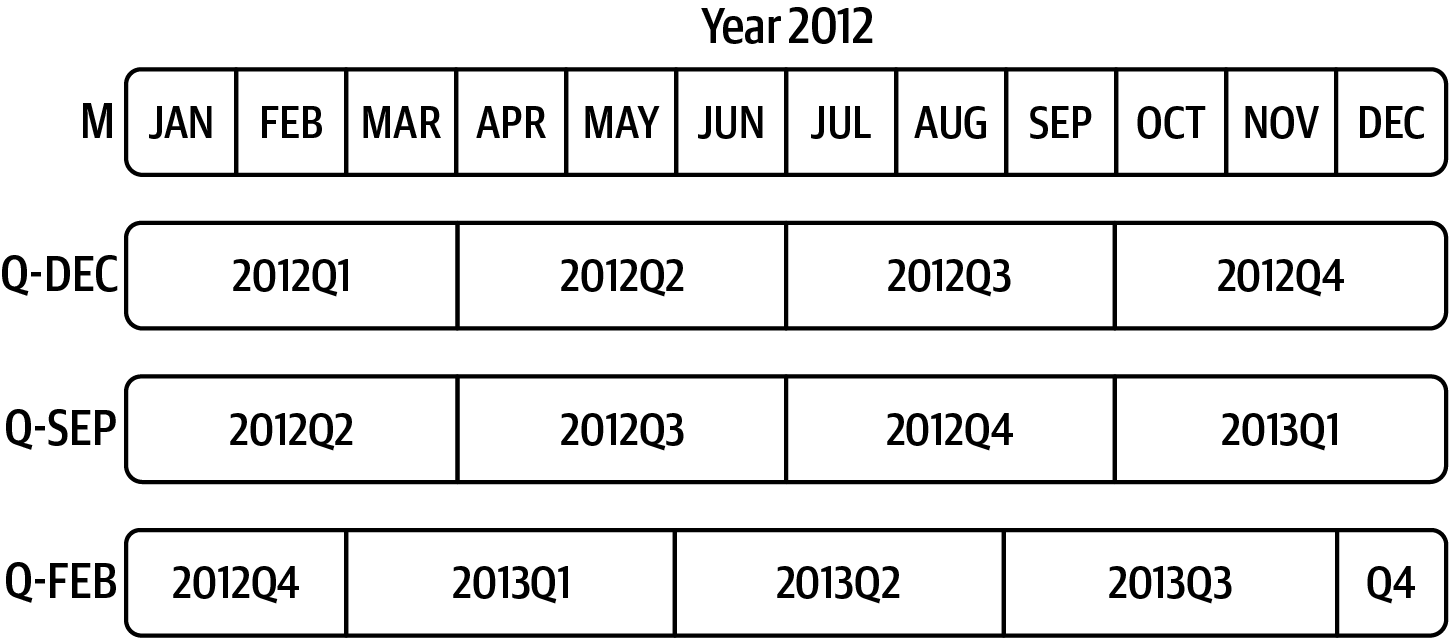
<그림 출처: Python for Data Analysis>
p4pm = (p.asfreq("B", how="end") - 1).asfreq("T", how="start") + 16 * 60
p4pm
Period('2012-01-30 16:00', 'T')
p4pm.to_timestamp()
Timestamp('2012-01-30 16:00:00')
periods = pd.period_range("2011Q3", "2012Q4", freq="Q-JAN")
ts = pd.Series(np.arange(len(periods)), index=periods)
ts
2011Q3 0
2011Q4 1
2012Q1 2
2012Q2 3
2012Q3 4
2012Q4 5
Freq: Q-JAN, dtype: int32
new_periods = (periods.asfreq("B", "end") - 1).asfreq("H", "start") + 16
ts.index = new_periods.to_timestamp()
ts
2010-10-28 16:00:00 0
2011-01-28 16:00:00 1
2011-04-28 16:00:00 2
2011-07-28 16:00:00 3
2011-10-28 16:00:00 4
2012-01-30 16:00:00 5
dtype: int32
28.5.3. 타임 스탬프와 기간#
dates = pd.date_range("2000-01-01", periods=3, freq="M")
ts = pd.Series(np.random.standard_normal(3), index=dates)
ts
2000-01-31 1.663261
2000-02-29 -0.996206
2000-03-31 1.521760
Freq: M, dtype: float64
pts = ts.to_period()
pts
2000-01 1.663261
2000-02 -0.996206
2000-03 1.521760
Freq: M, dtype: float64
dates = pd.date_range("2000-01-29", periods=6)
ts2 = pd.Series(np.random.standard_normal(6), index=dates)
ts2
2000-01-29 0.244175
2000-01-30 0.423331
2000-01-31 -0.654040
2000-02-01 2.089154
2000-02-02 -0.060220
2000-02-03 -0.167933
Freq: D, dtype: float64
ts2.to_period("M")
2000-01 0.244175
2000-01 0.423331
2000-01 -0.654040
2000-02 2.089154
2000-02 -0.060220
2000-02 -0.167933
Freq: M, dtype: float64
pts = ts2.to_period()
pts
2000-01-29 0.244175
2000-01-30 0.423331
2000-01-31 -0.654040
2000-02-01 2.089154
2000-02-02 -0.060220
2000-02-03 -0.167933
Freq: D, dtype: float64
pts.to_timestamp(how="end")
2000-01-29 23:59:59.999999999 0.244175
2000-01-30 23:59:59.999999999 0.423331
2000-01-31 23:59:59.999999999 -0.654040
2000-02-01 23:59:59.999999999 2.089154
2000-02-02 23:59:59.999999999 -0.060220
2000-02-03 23:59:59.999999999 -0.167933
Freq: D, dtype: float64
28.5.4. 기간 인덱스#
base_url = "https://raw.githubusercontent.com/codingalzi/datapy/master/jupyter-book/examples/"
file = "macrodata.csv"
data = pd.read_csv(base_url+file)
data.head(5)
| year | quarter | realgdp | realcons | realinv | realgovt | realdpi | cpi | m1 | tbilrate | unemp | pop | infl | realint | |
|---|---|---|---|---|---|---|---|---|---|---|---|---|---|---|
| 0 | 1959.0 | 1.0 | 2710.349 | 1707.4 | 286.898 | 470.045 | 1886.9 | 28.98 | 139.7 | 2.82 | 5.8 | 177.146 | 0.00 | 0.00 |
| 1 | 1959.0 | 2.0 | 2778.801 | 1733.7 | 310.859 | 481.301 | 1919.7 | 29.15 | 141.7 | 3.08 | 5.1 | 177.830 | 2.34 | 0.74 |
| 2 | 1959.0 | 3.0 | 2775.488 | 1751.8 | 289.226 | 491.260 | 1916.4 | 29.35 | 140.5 | 3.82 | 5.3 | 178.657 | 2.74 | 1.09 |
| 3 | 1959.0 | 4.0 | 2785.204 | 1753.7 | 299.356 | 484.052 | 1931.3 | 29.37 | 140.0 | 4.33 | 5.6 | 179.386 | 0.27 | 4.06 |
| 4 | 1960.0 | 1.0 | 2847.699 | 1770.5 | 331.722 | 462.199 | 1955.5 | 29.54 | 139.6 | 3.50 | 5.2 | 180.007 | 2.31 | 1.19 |
data["year"]
0 1959.0
1 1959.0
2 1959.0
3 1959.0
4 1960.0
...
198 2008.0
199 2008.0
200 2009.0
201 2009.0
202 2009.0
Name: year, Length: 203, dtype: float64
data["quarter"]
0 1.0
1 2.0
2 3.0
3 4.0
4 1.0
...
198 3.0
199 4.0
200 1.0
201 2.0
202 3.0
Name: quarter, Length: 203, dtype: float64
index = pd.PeriodIndex(year=data["year"], quarter=data["quarter"],
freq="Q-DEC")
index
PeriodIndex(['1959Q1', '1959Q2', '1959Q3', '1959Q4', '1960Q1', '1960Q2',
'1960Q3', '1960Q4', '1961Q1', '1961Q2',
...
'2007Q2', '2007Q3', '2007Q4', '2008Q1', '2008Q2', '2008Q3',
'2008Q4', '2009Q1', '2009Q2', '2009Q3'],
dtype='period[Q-DEC]', length=203)
data.index = index
data["infl"]
1959Q1 0.00
1959Q2 2.34
1959Q3 2.74
1959Q4 0.27
1960Q1 2.31
...
2008Q3 -3.16
2008Q4 -8.79
2009Q1 0.94
2009Q2 3.37
2009Q3 3.56
Freq: Q-DEC, Name: infl, Length: 203, dtype: float64
28.6. 리샘플링#
dates = pd.date_range("2000-01-01", periods=100)
ts = pd.Series(np.random.standard_normal(len(dates)), index=dates)
ts
2000-01-01 0.631634
2000-01-02 -1.594313
2000-01-03 -1.519937
2000-01-04 1.108752
2000-01-05 1.255853
...
2000-04-05 -0.423776
2000-04-06 0.789740
2000-04-07 0.937568
2000-04-08 -2.253294
2000-04-09 -1.772919
Freq: D, Length: 100, dtype: float64
ts.resample("M").mean()
2000-01-31 -0.165893
2000-02-29 0.078606
2000-03-31 0.223811
2000-04-30 -0.063643
Freq: M, dtype: float64
ts.resample("M", kind="period").mean()
2000-01 -0.165893
2000-02 0.078606
2000-03 0.223811
2000-04 -0.063643
Freq: M, dtype: float64
28.6.1. 다운 샘플링#
dates = pd.date_range("2000-01-01", periods=12, freq="T")
ts = pd.Series(np.arange(len(dates)), index=dates)
ts
2000-01-01 00:00:00 0
2000-01-01 00:01:00 1
2000-01-01 00:02:00 2
2000-01-01 00:03:00 3
2000-01-01 00:04:00 4
2000-01-01 00:05:00 5
2000-01-01 00:06:00 6
2000-01-01 00:07:00 7
2000-01-01 00:08:00 8
2000-01-01 00:09:00 9
2000-01-01 00:10:00 10
2000-01-01 00:11:00 11
Freq: T, dtype: int32
ts.resample("5min").sum()
2000-01-01 00:00:00 10
2000-01-01 00:05:00 35
2000-01-01 00:10:00 21
Freq: 5T, dtype: int32
ts.resample("5min", closed="right").sum()
1999-12-31 23:55:00 0
2000-01-01 00:00:00 15
2000-01-01 00:05:00 40
2000-01-01 00:10:00 11
Freq: 5T, dtype: int32
ts.resample("5min", closed="right", label="right").sum()
2000-01-01 00:00:00 0
2000-01-01 00:05:00 15
2000-01-01 00:10:00 40
2000-01-01 00:15:00 11
Freq: 5T, dtype: int32

<그림 출처: Python for Data Analysis>
from pandas.tseries.frequencies import to_offset
result = ts.resample("5min", closed="right", label="right").sum()
result.index = result.index + to_offset("-1s")
result
1999-12-31 23:59:59 0
2000-01-01 00:04:59 15
2000-01-01 00:09:59 40
2000-01-01 00:14:59 11
Freq: 5T, dtype: int32
ts = pd.Series(np.random.permutation(np.arange(len(dates))), index=dates)
ts.resample("5min").ohlc()
| open | high | low | close | |
|---|---|---|---|---|
| 2000-01-01 00:00:00 | 8 | 8 | 1 | 5 |
| 2000-01-01 00:05:00 | 6 | 11 | 2 | 2 |
| 2000-01-01 00:10:00 | 0 | 7 | 0 | 7 |
28.6.2. 업샘플링과 보간법#
frame = pd.DataFrame(np.random.standard_normal((2, 4)),
index=pd.date_range("2000-01-01", periods=2,
freq="W-WED"),
columns=["Colorado", "Texas", "New York", "Ohio"])
frame
| Colorado | Texas | New York | Ohio | |
|---|---|---|---|---|
| 2000-01-05 | -0.896431 | 0.927238 | 0.482284 | -0.867130 |
| 2000-01-12 | 0.493841 | -0.155434 | 1.397286 | 1.507055 |
df_daily = frame.resample("D").asfreq()
df_daily
| Colorado | Texas | New York | Ohio | |
|---|---|---|---|---|
| 2000-01-05 | -0.896431 | 0.927238 | 0.482284 | -0.867130 |
| 2000-01-06 | NaN | NaN | NaN | NaN |
| 2000-01-07 | NaN | NaN | NaN | NaN |
| 2000-01-08 | NaN | NaN | NaN | NaN |
| 2000-01-09 | NaN | NaN | NaN | NaN |
| 2000-01-10 | NaN | NaN | NaN | NaN |
| 2000-01-11 | NaN | NaN | NaN | NaN |
| 2000-01-12 | 0.493841 | -0.155434 | 1.397286 | 1.507055 |
frame.resample("D").ffill()
| Colorado | Texas | New York | Ohio | |
|---|---|---|---|---|
| 2000-01-05 | -0.896431 | 0.927238 | 0.482284 | -0.867130 |
| 2000-01-06 | -0.896431 | 0.927238 | 0.482284 | -0.867130 |
| 2000-01-07 | -0.896431 | 0.927238 | 0.482284 | -0.867130 |
| 2000-01-08 | -0.896431 | 0.927238 | 0.482284 | -0.867130 |
| 2000-01-09 | -0.896431 | 0.927238 | 0.482284 | -0.867130 |
| 2000-01-10 | -0.896431 | 0.927238 | 0.482284 | -0.867130 |
| 2000-01-11 | -0.896431 | 0.927238 | 0.482284 | -0.867130 |
| 2000-01-12 | 0.493841 | -0.155434 | 1.397286 | 1.507055 |
frame.resample("D").ffill(limit=2)
| Colorado | Texas | New York | Ohio | |
|---|---|---|---|---|
| 2000-01-05 | -0.896431 | 0.927238 | 0.482284 | -0.867130 |
| 2000-01-06 | -0.896431 | 0.927238 | 0.482284 | -0.867130 |
| 2000-01-07 | -0.896431 | 0.927238 | 0.482284 | -0.867130 |
| 2000-01-08 | NaN | NaN | NaN | NaN |
| 2000-01-09 | NaN | NaN | NaN | NaN |
| 2000-01-10 | NaN | NaN | NaN | NaN |
| 2000-01-11 | NaN | NaN | NaN | NaN |
| 2000-01-12 | 0.493841 | -0.155434 | 1.397286 | 1.507055 |
frame.resample("W-THU").ffill()
| Colorado | Texas | New York | Ohio | |
|---|---|---|---|---|
| 2000-01-06 | -0.896431 | 0.927238 | 0.482284 | -0.867130 |
| 2000-01-13 | 0.493841 | -0.155434 | 1.397286 | 1.507055 |
28.6.3. 기간 활용 리샘플링#
frame = pd.DataFrame(np.random.standard_normal((24, 4)),
index=pd.period_range("1-2000", "12-2001",
freq="M"),
columns=["Colorado", "Texas", "New York", "Ohio"])
frame.head()
| Colorado | Texas | New York | Ohio | |
|---|---|---|---|---|
| 2000-01 | -1.179442 | 0.443171 | 1.395676 | -0.529658 |
| 2000-02 | 0.787358 | 0.248845 | 0.743239 | 1.267746 |
| 2000-03 | 1.302395 | -0.272154 | -0.051532 | -0.467740 |
| 2000-04 | -1.040816 | 0.426419 | 0.312945 | -1.115689 |
| 2000-05 | 1.234297 | -1.893094 | -1.661605 | -0.005477 |
annual_frame = frame.resample("A-DEC").mean()
annual_frame
| Colorado | Texas | New York | Ohio | |
|---|---|---|---|---|
| 2000 | 0.487329 | 0.104466 | 0.020495 | -0.273945 |
| 2001 | 0.203125 | 0.162429 | 0.056146 | -0.103794 |
# Q-DEC: Quarterly, year ending in December
annual_frame.resample("Q-DEC").ffill()
| Colorado | Texas | New York | Ohio | |
|---|---|---|---|---|
| 2000Q1 | 0.487329 | 0.104466 | 0.020495 | -0.273945 |
| 2000Q2 | 0.487329 | 0.104466 | 0.020495 | -0.273945 |
| 2000Q3 | 0.487329 | 0.104466 | 0.020495 | -0.273945 |
| 2000Q4 | 0.487329 | 0.104466 | 0.020495 | -0.273945 |
| 2001Q1 | 0.203125 | 0.162429 | 0.056146 | -0.103794 |
| 2001Q2 | 0.203125 | 0.162429 | 0.056146 | -0.103794 |
| 2001Q3 | 0.203125 | 0.162429 | 0.056146 | -0.103794 |
| 2001Q4 | 0.203125 | 0.162429 | 0.056146 | -0.103794 |
annual_frame.resample("Q-DEC", convention="end").asfreq()
| Colorado | Texas | New York | Ohio | |
|---|---|---|---|---|
| 2000Q4 | 0.487329 | 0.104466 | 0.020495 | -0.273945 |
| 2001Q1 | NaN | NaN | NaN | NaN |
| 2001Q2 | NaN | NaN | NaN | NaN |
| 2001Q3 | NaN | NaN | NaN | NaN |
| 2001Q4 | 0.203125 | 0.162429 | 0.056146 | -0.103794 |
annual_frame.resample("Q-MAR").ffill()
| Colorado | Texas | New York | Ohio | |
|---|---|---|---|---|
| 2000Q4 | 0.487329 | 0.104466 | 0.020495 | -0.273945 |
| 2001Q1 | 0.487329 | 0.104466 | 0.020495 | -0.273945 |
| 2001Q2 | 0.487329 | 0.104466 | 0.020495 | -0.273945 |
| 2001Q3 | 0.487329 | 0.104466 | 0.020495 | -0.273945 |
| 2001Q4 | 0.203125 | 0.162429 | 0.056146 | -0.103794 |
| 2002Q1 | 0.203125 | 0.162429 | 0.056146 | -0.103794 |
| 2002Q2 | 0.203125 | 0.162429 | 0.056146 | -0.103794 |
| 2002Q3 | 0.203125 | 0.162429 | 0.056146 | -0.103794 |
28.6.4. 시간 리샘플링 그룹화#
N = 15
times = pd.date_range("2017-05-20 00:00", freq="1min", periods=N)
df = pd.DataFrame({"time": times,
"value": np.arange(N)})
df
| time | value | |
|---|---|---|
| 0 | 2017-05-20 00:00:00 | 0 |
| 1 | 2017-05-20 00:01:00 | 1 |
| 2 | 2017-05-20 00:02:00 | 2 |
| 3 | 2017-05-20 00:03:00 | 3 |
| 4 | 2017-05-20 00:04:00 | 4 |
| 5 | 2017-05-20 00:05:00 | 5 |
| 6 | 2017-05-20 00:06:00 | 6 |
| 7 | 2017-05-20 00:07:00 | 7 |
| 8 | 2017-05-20 00:08:00 | 8 |
| 9 | 2017-05-20 00:09:00 | 9 |
| 10 | 2017-05-20 00:10:00 | 10 |
| 11 | 2017-05-20 00:11:00 | 11 |
| 12 | 2017-05-20 00:12:00 | 12 |
| 13 | 2017-05-20 00:13:00 | 13 |
| 14 | 2017-05-20 00:14:00 | 14 |
df.set_index("time").resample("5min").count()
| value | |
|---|---|
| time | |
| 2017-05-20 00:00:00 | 5 |
| 2017-05-20 00:05:00 | 5 |
| 2017-05-20 00:10:00 | 5 |
df2 = pd.DataFrame({"time": times.repeat(3),
"key": np.tile(["a", "b", "c"], N),
"value": np.arange(N * 3.)})
df2.head(7)
| time | key | value | |
|---|---|---|---|
| 0 | 2017-05-20 00:00:00 | a | 0.0 |
| 1 | 2017-05-20 00:00:00 | b | 1.0 |
| 2 | 2017-05-20 00:00:00 | c | 2.0 |
| 3 | 2017-05-20 00:01:00 | a | 3.0 |
| 4 | 2017-05-20 00:01:00 | b | 4.0 |
| 5 | 2017-05-20 00:01:00 | c | 5.0 |
| 6 | 2017-05-20 00:02:00 | a | 6.0 |
time_key = pd.Grouper(freq="5min")
resampled = (df2.set_index("time")
.groupby(["key", time_key])
.sum())
resampled
| value | ||
|---|---|---|
| key | time | |
| a | 2017-05-20 00:00:00 | 30.0 |
| 2017-05-20 00:05:00 | 105.0 | |
| 2017-05-20 00:10:00 | 180.0 | |
| b | 2017-05-20 00:00:00 | 35.0 |
| 2017-05-20 00:05:00 | 110.0 | |
| 2017-05-20 00:10:00 | 185.0 | |
| c | 2017-05-20 00:00:00 | 40.0 |
| 2017-05-20 00:05:00 | 115.0 | |
| 2017-05-20 00:10:00 | 190.0 |
resampled.reset_index()
| key | time | value | |
|---|---|---|---|
| 0 | a | 2017-05-20 00:00:00 | 30.0 |
| 1 | a | 2017-05-20 00:05:00 | 105.0 |
| 2 | a | 2017-05-20 00:10:00 | 180.0 |
| 3 | b | 2017-05-20 00:00:00 | 35.0 |
| 4 | b | 2017-05-20 00:05:00 | 110.0 |
| 5 | b | 2017-05-20 00:10:00 | 185.0 |
| 6 | c | 2017-05-20 00:00:00 | 40.0 |
| 7 | c | 2017-05-20 00:05:00 | 115.0 |
| 8 | c | 2017-05-20 00:10:00 | 190.0 |
28.7. 윈도우 함수 활용#
base_url = "https://raw.githubusercontent.com/codingalzi/datapy/master/jupyter-book/examples/"
file = "stock_px.csv"
close_px_all = pd.read_csv(base_url+file, parse_dates=True, index_col=0)
close_px = close_px_all[["AAPL", "MSFT", "XOM"]]
close_px = close_px.resample("B").ffill()
close_px["AAPL"].plot()
<Axes: >
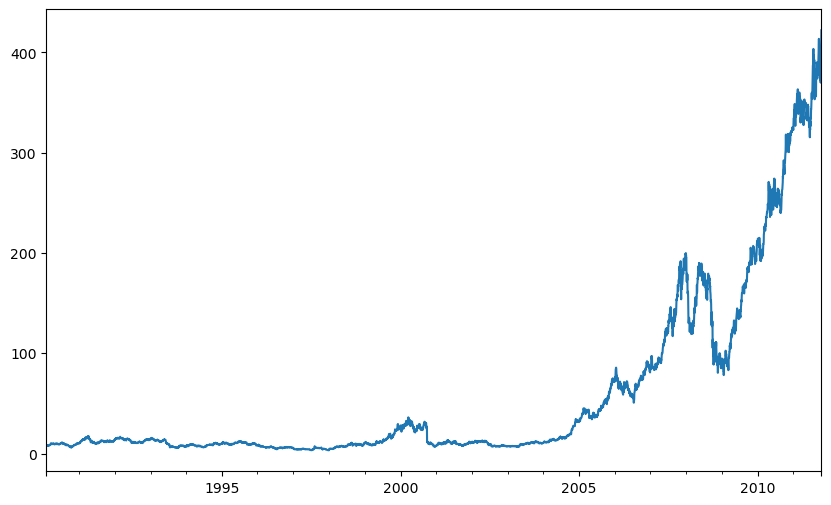
#! figure,id=apple_daily_ma250,title="Apple price with 250-day moving average"
close_px["AAPL"].rolling(250).mean().plot()
<Axes: >
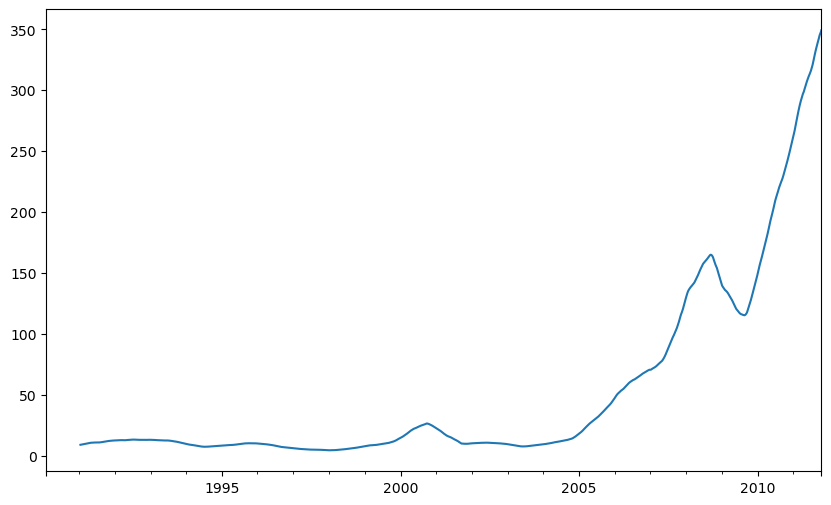
plt.figure()
std250 = close_px["AAPL"].pct_change().rolling(250, min_periods=10).std()
std250[5:12]
#! figure,id=apple_daily_std250,title="Apple 250-day daily return standard deviation"
std250.plot()
<Axes: >
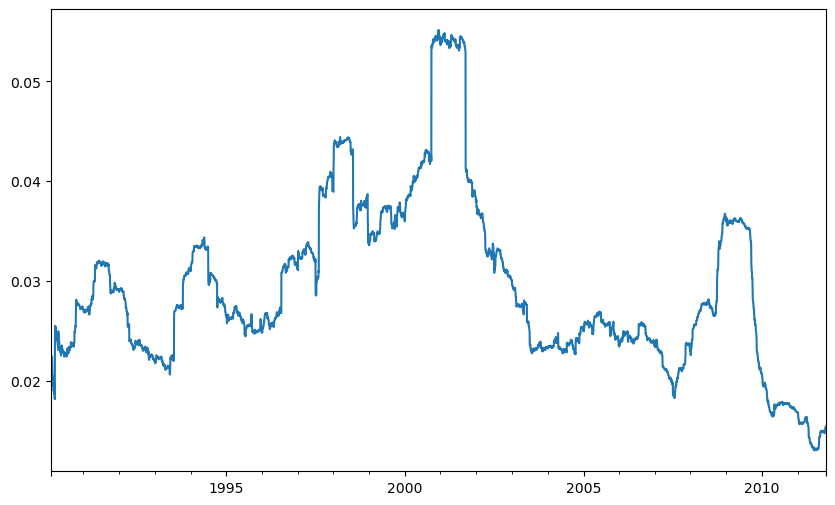
expanding_mean = std250.expanding().mean()
plt.figure()
plt.style.use('grayscale')
#! figure,id=stocks_daily_ma60,title="Stock prices 60-day moving average (log y-axis)"
close_px.rolling(60).mean().plot(logy=True)
<Axes: >
<Figure size 1000x600 with 0 Axes>
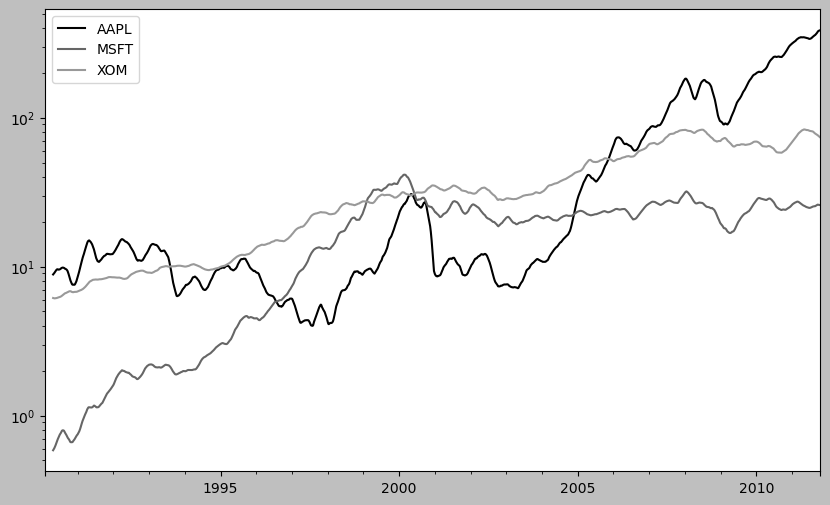
close_px.rolling("20D").mean()
| AAPL | MSFT | XOM | |
|---|---|---|---|
| 1990-02-01 | 7.860000 | 0.510000 | 6.120000 |
| 1990-02-02 | 7.930000 | 0.510000 | 6.180000 |
| 1990-02-05 | 8.013333 | 0.510000 | 6.203333 |
| 1990-02-06 | 8.040000 | 0.510000 | 6.210000 |
| 1990-02-07 | 7.986000 | 0.510000 | 6.234000 |
| ... | ... | ... | ... |
| 2011-10-10 | 389.351429 | 25.602143 | 72.527857 |
| 2011-10-11 | 388.505000 | 25.674286 | 72.835000 |
| 2011-10-12 | 388.531429 | 25.810000 | 73.400714 |
| 2011-10-13 | 388.826429 | 25.961429 | 73.905000 |
| 2011-10-14 | 391.038000 | 26.048667 | 74.185333 |
5662 rows × 3 columns
28.7.1. 지수 가중치 함수#
plt.figure()
aapl_px = close_px["AAPL"]["2006":"2007"]
ma30 = aapl_px.rolling(30, min_periods=20).mean()
ewma30 = aapl_px.ewm(span=30).mean()
aapl_px.plot(style="k-", label="Price")
ma30.plot(style="k--", label="Simple Moving Avg")
ewma30.plot(style="k-", label="EW MA")
#! figure,id=timeseries_ewma,title="Simple moving average versus exponentially weighted"
plt.legend()
<matplotlib.legend.Legend at 0x255a3259000>

28.7.2. 이진 이동 윈도우 함수#
plt.figure()
spx_px = close_px_all["SPX"]
spx_rets = spx_px.pct_change()
returns = close_px.pct_change()
corr = returns["AAPL"].rolling(125, min_periods=100).corr(spx_rets)
#! figure,id=roll_correl_aapl,title="Six-month AAPL return correlation to S&P 500"
corr.plot()
<Axes: >
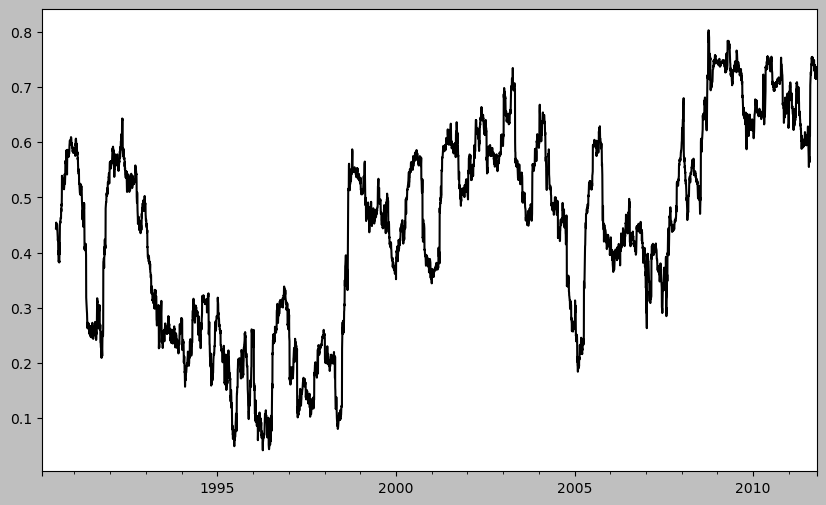
plt.figure()
corr = returns.rolling(125, min_periods=100).corr(spx_rets)
#! figure,id=roll_correl_all,title="Six-month return correlations to S&P 500"
corr.plot()
<Axes: >
<Figure size 1000x600 with 0 Axes>
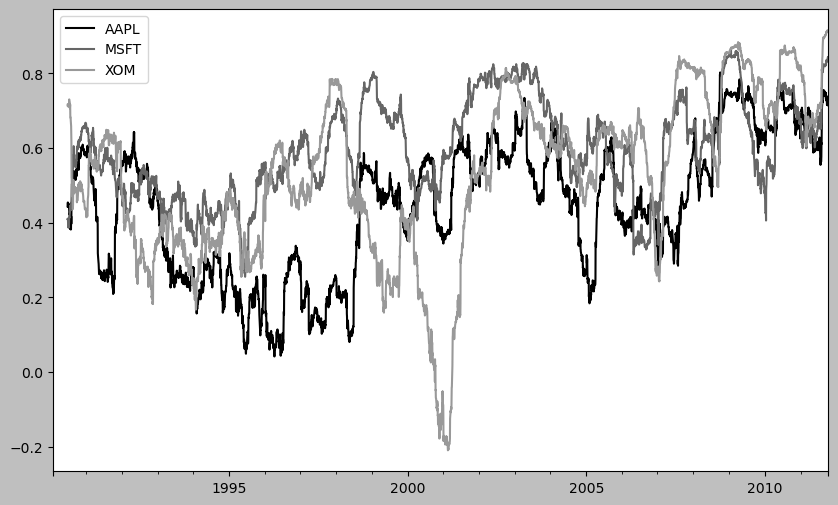
28.7.3. 사용자 정의 윈도우 함수#
plt.figure()
from scipy.stats import percentileofscore
def score_at_2percent(x):
return percentileofscore(x, 0.02)
result = returns["AAPL"].rolling(250).apply(score_at_2percent)
#! figure,id=roll_apply_ex,title="Percentile rank of 2% AAPL return over one-year window"
result.plot()
<Axes: >

